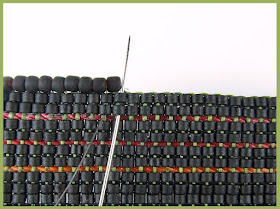You may recall one of my recent cuffs, using C-Lon Tex 400 for the warps. I wove it 'row-by-row'. It was also the cuff being woven when I came up with a new idea of how to create a custom clasp. Here is the clasp I attached to that cuff.

for this 'Gerber Daisy Cuff'.
I will use gunmetal for all the findings, in this cuff. Gunmetal finishes will match perfectly.
There are some wild, fun, bright colors in this pattern, not to mention the extension of each petal and the over hang of my 'symbolic leaf design', so a simple edge would be best. The matte black is also a perfect color to extend, for this edge.
My personal favorite edging is a simple, single line of turned beads. I started using this idea on my weavings years ago. I call it just that, a ©Simple Turned Bead Edge.
To complete this edge, you will be running your needle in and out of the last few rows of the woven edge. Usually, I am looking to not create a bulk of thread, turning my thread in and out of the same beads. This design, using the thick warp threads, don't make a difference. I'll be turning my thread through the same two beads, every pass because the line of thick thread will hide all of extra passes of thread. For a further design aspect, consider adding an 11/0 seed bead, every turn-up.

Many are already completed, but let me begin with how to do this ©Simple Turned Bead Edging. Above you see I attached a 11/0 matte black 'seed bead' (not Delicas, for this type of edging).
Below, I added another 11/0 matte black seed bead, but turned my needle back into the same row I just exited. Notice how I will be falling in and out of each bead more than once. It is the turn back out, that I mentioned above, where the thread could become too thick, turning at the same woven beads. The thick Tex 400 warp will help it not be a problem, but remember to keep this in mind, when weaving, with thinner warps.

Shown below, I am exiting to the right again. In essence, you will be looping your thread around sets of woven beads, two hear, adding a single 11/0 seed bead with every pass, along the top edge.

Once you reach the end of the cuff edge, or are butt against the extended design, turn your needle and thread back through every bead you just added. This will not only secure them on the edge, but will eliminate them from falling forward and backward from each other bead, while being worn.

To complete the other side of the petal extensions, I attached a new thread, completing the same steps I outlined above.

Looking at this closely, I decided not to edge the side where I warped with C-Lon Tex 400, in green. Personally, I never leave a bead open along an edge, a pet peeve of mine, but the thickness of the Tex 400 carries enough weight to fill that gap, covering the entire thickness of the woven Delicas.
Knowing earlier I wasn't edging 'both' sides of the cuff edge, I completed the 'symbolic leaf design'. Otherwise, I would have edged, then added the leaf design. Since edging is a fixed step, in all of my woven creations, I think ahead as far as I can to realize what step is best completed first, an extended design or the edging.

Next, I will complete the fringe idea, but right now, I am still looking over my stash of beads to pick what I think will work best :)












































